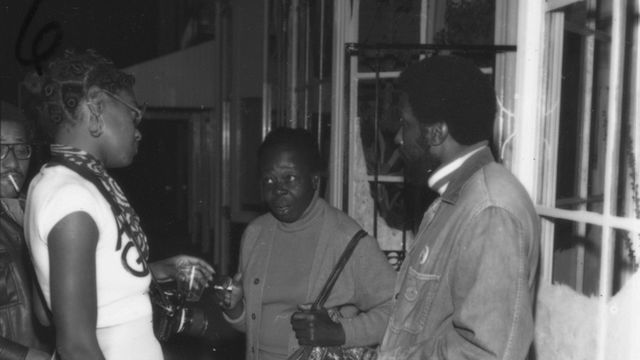
Ruth Waddy
Upon receiving an honorary doctorate in fine art from Otis Art Institute of Parsons School of Design in 1987, Ruth Gilliam Waddy was lauded as a "painter, printmaker, and advocate of artistic opportunity" and a "prophet exclaiming the news of black artists and calling upon the world to embrace them."# Indeed, in the late 1960s Waddy became one of the most important advocates for African American art in California and across the United States.
After trying to make a living in Chicago, where she was denied a job as a solderer during World War II because of her race, Waddy, then a young mother, left the Midwest for Los Angeles. In California she worked as a riveter for Douglas Aircraft Corporation and held other odd jobs (including as an intake clerk at Los Angeles County Hospital, where she worked with Noah Purifoy) before taking a ceramics class that sparked her interest in art. Waddy went on to study art through the Famous Artists Home Study Course and at Los Angeles City College and Otis Art Institute, quickly becoming an adept printmaker whose favored medium was linocut. She exhibited her prints widely in the United States and traveled to the Soviet Union in 1966 as part of a delegation of eight American artists. Traveling on the recommendation of Charles White, who had made the same trip several years earlier, Waddy carried her own work abroad as well as twenty prints created by other black California artists.#
Before her trip to the U.S.S.R., Waddy had journeyed cross-country via Greyhound bus to collect prints by black artists for the 1965 volume Prints by American Negro Artists, edited by Theodore V. Roelof-Lanner and published by the Cultural Exchange Center in Los Angeles. In 1969 Waddy also contributed her extensive knowledge of contemporary African American artists to the influential two-volume series Black Artists on Art, coedited with artist, teacher, and gallerist Samella S. Lewis. In her introduction, Waddy clearly outlines her view of art making: "Art is not an intellectual exercise, approached through structured learning, emotions, styles, and practised [sic] in museums, galleries, and private 'collections.' Art is spiritual, the primary function of which is for the benefit, growth and improvement of the human animal." She adds, "From whatever point of view, aesthetic or social, [the black artist] has always had to tell it 'like it is.'"#
Waddy's own work, included at the end of the first volume, was represented by an array of linocuts from the mid-1960s. Her stylistically diverse prints depict abstracted African motifs, floral still lifes, pastoral genre scenes, and explicitly political subjects, such as a group of African revolutionaries in the 1969 linocut The Key, which dramatically frames its central figures with dark black geometric forms. Working from a scrapbook of images clipped from newspapers and magazines, Waddy chose subjects from everyday life—fruit and flowers, for example—that are, in her words, about "color, whimsy, joy," in addition to being affecting images of social strife.#
Despite Waddy's achievements as a fine artist, she always insisted on characterizing herself first and foremost as an arts organizer and advocate. In addition to her work with Roelof-Lanner and Lewis, Waddy brought together a group of preeminent black artists to form the organization Art West Associated. Beginning with little knowledge of the Los Angeles art scene, Waddy collected the names of black artists making work respected by their peers. She first contacted Daniel LaRue Johnson, who directed her to Melvin Edwards, who in turn told her about George Clack, and so on. Describing herself as a nonartist, Waddy convened a meeting of black artists in 1962 in the back room at the Safety Savings and Loan Company, where Art West Associated was born.
With funding from the National Endowment for the Arts as well as other local arts programs, Art West Associated organized juried shows and sold prints through advertisements in African American magazines such as Essence, among other activities. The Los Angeles–based group had a sister chapter in San Francisco called Art West Associated North. For her central role in bringing artists together to promote their work, Waddy did not go unrecognized. She received numerous national awards for leadership over the course of her career and has been regarded with great admiration by those with whom she worked. As artist Alonzo Davis remarked, "What I got from Ruth was her strength of belief in the African American culture."#
—Andrea Gyorody
Selected Exhibitions
Solo exhibition, Jimmy Crawford's Frame Shop, Los Angeles, 1964.
Internationale Buchkunst-Ausstellung, Leipzig, East Germany, 1965.
The Negro in American Art, Dickson Art Galleries, University of California, Los Angeles, 1966.
New Perspectives in Black Art, Kaiser Center, Oakland, 1968.
Black Mirror, Womanspace Gallery, Los Angeles, 1973.
Prints by Ruth Waddy, Scott United Methodist Church, Pasadena, 1976.
Black California Women Artists, California African American Museum, Los Angeles, 1985.
Ruth Waddy: A Retrospective, Gallery Plus, Los Angeles, 1986.
Selected Bibliography
"'Black Mirror' at Womanspace." Los Angeles Sentinel, April 12, 1973.
"Black Women Artist Exhibit Starts." Los Angeles Sentinel, July 22, 1982.
Lewis, Samella S., and Ruth G. Waddy. Black Artists on Art. Vol. 1. Los Angeles: Contemporary Crafts, 1969.
Moore, Ronald. "City Honors Twelve Black Artists." Los Angeles Sentinel, May 1, 1981.
"Museum Showcases Black Women Artists." Los Angeles Sentinel, July 25, 1985.
"Ruth Waddy: Late-Blooming, Talented Artist." Los Angeles Sentinel, April 14, 1983.
Waddy, Ruth G., interview by Karen Anne Mason, October 1990–April 1991 and July 26–28, 1991. African American Artists of Los Angeles, Oral History Program, University of California, Los Angeles. Transcript, Charles E. Young Research Library, Department of Special Collections, UCLA.
Widener, Daniel. Black Arts West: Culture and Struggle in Postwar Los Angeles. Durham, N.C.: Duke University Press, 2010.
Selected Links
Ruth Waddy Wikipedia page.
"The Ruth Waddy Sketchbook," LACMA’s Unframed, July 12, 2011.
"The Ruth Waddy Sketchbook," uploaded to YouTube by the Los Angeles County Museum of Art, July 31, 2011.
"Black Artists on Art: The Legacy Exhibit," Oakstop, February 2, 2015.


